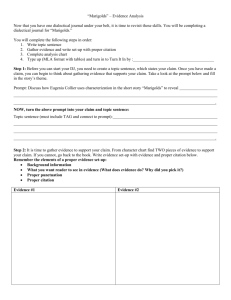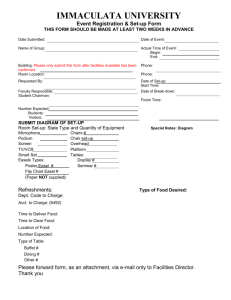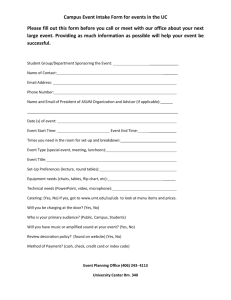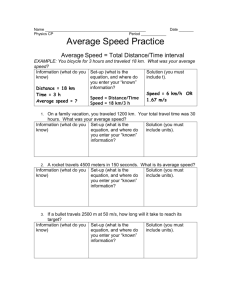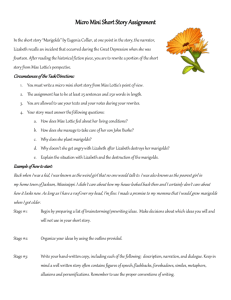cheat sheet for evidence
advertisement
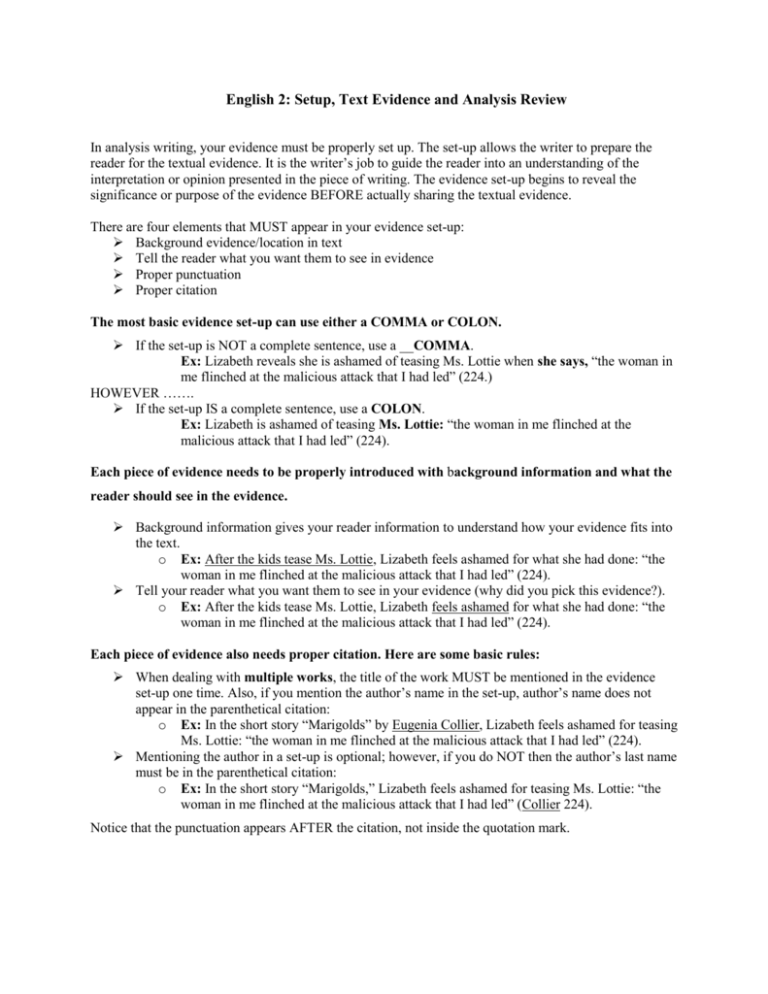
English 2: Setup, Text Evidence and Analysis Review In analysis writing, your evidence must be properly set up. The set-up allows the writer to prepare the reader for the textual evidence. It is the writer’s job to guide the reader into an understanding of the interpretation or opinion presented in the piece of writing. The evidence set-up begins to reveal the significance or purpose of the evidence BEFORE actually sharing the textual evidence. There are four elements that MUST appear in your evidence set-up: Background evidence/location in text Tell the reader what you want them to see in evidence Proper punctuation Proper citation The most basic evidence set-up can use either a COMMA or COLON. If the set-up is NOT a complete sentence, use a __COMMA. Ex: Lizabeth reveals she is ashamed of teasing Ms. Lottie when she says, “the woman in me flinched at the malicious attack that I had led” (224.) HOWEVER ……. If the set-up IS a complete sentence, use a COLON. Ex: Lizabeth is ashamed of teasing Ms. Lottie: “the woman in me flinched at the malicious attack that I had led” (224). Each piece of evidence needs to be properly introduced with background information and what the reader should see in the evidence. Background information gives your reader information to understand how your evidence fits into the text. o Ex: After the kids tease Ms. Lottie, Lizabeth feels ashamed for what she had done: “the woman in me flinched at the malicious attack that I had led” (224). Tell your reader what you want them to see in your evidence (why did you pick this evidence?). o Ex: After the kids tease Ms. Lottie, Lizabeth feels ashamed for what she had done: “the woman in me flinched at the malicious attack that I had led” (224). Each piece of evidence also needs proper citation. Here are some basic rules: When dealing with multiple works, the title of the work MUST be mentioned in the evidence set-up one time. Also, if you mention the author’s name in the set-up, author’s name does not appear in the parenthetical citation: o Ex: In the short story “Marigolds” by Eugenia Collier, Lizabeth feels ashamed for teasing Ms. Lottie: “the woman in me flinched at the malicious attack that I had led” (224). Mentioning the author in a set-up is optional; however, if you do NOT then the author’s last name must be in the parenthetical citation: o Ex: In the short story “Marigolds,” Lizabeth feels ashamed for teasing Ms. Lottie: “the woman in me flinched at the malicious attack that I had led” (Collier 224). Notice that the punctuation appears AFTER the citation, not inside the quotation mark. Examples: 1. Write evidence set-up with quote using a comma and provide proper in-text citation: After he escapes jail and flees, the author creates a sense of uncertainty about what disaster will befall Orrin Brower when he states, “he had the folly to enter a forest” (xx). 2. Write evidence set-up with quote using a colon and provide proper in-text citation: The author creates a sense of uncertainty about what disaster will befall Orrin Brower after he escapes jail and flees: “he had the folly to enter a forest” (xx). 3. Write evidence set-up with title of work and author mentioned in set up, using proper in-text citation: In the short story “An Arrest,” author Ambrose Bierce creates a sense of uncertainty about what disaster will befall Orrin Brower after he escapes jail and flees: “he had the folly to enter a forest” (xx). What is TAG? Title of the work - short stories, articles, poems use “quotation marks.” Longer works are italicized. Author - last name is sufficient Genre – short story, newspaper article, poem, novel, etc. You do NOT have to keep repeating the TAG. Analysis: How the text evidence supports the claim. Include literary element(s) used by the author. Examples: suspense, diction, symbolism, characterization, Several sentences long. This is in-depth and thoughtful. Refers directly back to the evidence included and is specific to that evidence. Do not be repetitive. Dialectical Journal: This is completed as it appears in the boxes. Blank DJ templates are available on my website or you can simply create a table in Microsoft Word. Be sure to use MLA formatting with hear, heading, unique title, 12 point font and double spacing. John Smith Mrs. Simpson English 2-Period 10 September 2015 Your Name Teacher Name Course –Period # Last name Page # Day Month Year Pushy Mom Pushes Too Far Setup and evidence on the left: Title is centered Analysis on the right: Tan underscores the daughter’s anger and By using careful diction like “never” disappointment at the ideal of never readers feel Jing-mei’s devastation. being able to meet her mother’s Her disappointment seems infinite, expectations: “I will never be the kind of like no matter what she does she is daughter you want me to be!” (106). never going to fit the mold of the “perfect daughter.” “Never” creates *These have room for improvement! * a sense of hopelessness for Jing-mei. Repeat for next pieces of evidence and analysis. This is easily turned into a précis when the time comes.
